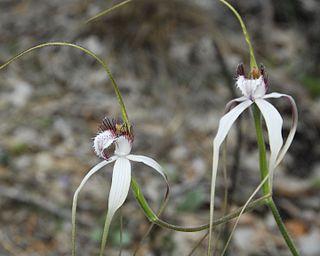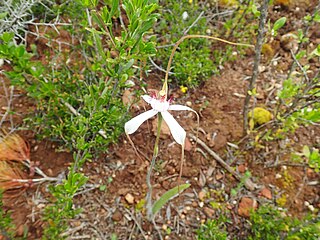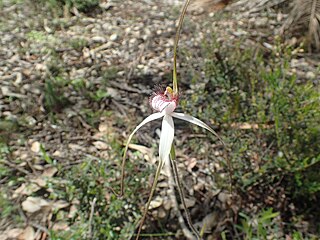
Caladenia longicauda is a species of plant in the orchid family Orchidaceae and is endemic to the south-west of Western Australia. It is distinguished by its large leaf and by its up to five large, white flowers which have drooping sepals and petals with long, thickish brown "tails".

Caladenia longicauda subspecies borealis, commonly known as daddy-long-legs spider orchid is a plant in the orchid family Orchidaceae and is endemic to the south-west of Western Australia. It has a single hairy leaf and up to three mostly white flowers with long, drooping sepals and petals.

Caladenia denticulata subsp. denticulata, commonly known as the yellow spider orchid, is a plant in the orchid family Orchidaceae and is endemic to the south-west of Western Australia. It has a single erect, hairy leaf and one or two yellowish flowers which have a white labellum with pale red markings.
Caladenia denticulata subsp. albicans, commonly known as the alabaster spider orchid, is a plant in the orchid family Orchidaceae and is endemic to the south-west of Western Australia. It has a single erect, hairy leaf and one or two pale creamy-white flowers which have a white labellum with red markings. The only known population occurs in a small area near Arrowsmith.
Caladenia denticulata subsp. rubella, commonly known as the clumped spider orchid, is a plant in the orchid family Orchidaceae and is endemic to the south-west of Western Australia. It has a single erect, hairy leaf and one or two dull or pinkish red flowers with prominent dull red markings and with a white labellum with red markings.
Caladenia longicauda subsp. albella, commonly known as the small-lipped white spider orchid, is a plant in the orchid family Orchidaceae and is endemic to the south-west of Western Australia. It has a single hairy leaf and up to four, mostly white flowers which have a pungent smell. It usually grows in seasonal swamps between Eneabba and Gingin.

Caladenia longicauda subsp. australora, commonly known as the southern white spider orchid, is a plant in the orchid family Orchidaceae and is endemic to the south-west of Western Australia. It has a single hairy leaf and up to three mostly white, relatively small flowers. It grows in woodland and mallee on the south coast in and near the Fitzgerald River National Park.

Caladenia longicauda subsp. calcigena, commonly known as the coastal white spider orchid, is a plant in the orchid family Orchidaceae and is endemic to the south-west of Western Australia. It has a single hairy leaf and up to four mostly white flowers. It grows in coastal sand on the west coast and is distinguished from other subspecies growing in the same area, by its longer sepals and petals, small, narrow labellum and by the arrangement of the calli on its labellum.

Caladenia longicauda subsp. clivicola, commonly known as the Darling Scarp white spider orchid, or hills white spider orchid is a plant in the orchid family Orchidaceae and is endemic to the south-west of Western Australia. It has a single hairy leaf and up to three mostly white flowers with long, drooping lateral sepals and petals, a relatively small, narrow labellum and narrow labellum teeth. It grows in a restricted area, mostly on the Darling Scarp.

Caladenia longicauda subsp. crassa, commonly known as the Esperance white spider orchid, is a plant in the orchid family Orchidaceae and is endemic to the south-west of Western Australia. It has a single hairy leaf and up to three mostly white flowers with long, broad, spreading lateral sepals and petals, a relatively broad labellum with short, narrow teeth. It grows on the south coast between Bremer Bay and the Cape Arid National Park.

Caladenia longicauda subsp. eminens, commonly known as the stark white spider orchid, is a plant in the orchid family Orchidaceae and is endemic to the south-west of Western Australia. It has a single hairy leaf and up to three large, bright white flowers with long, broad, spreading lateral sepals and petals, a relatively broad labellum with short, narrow teeth. It is a relatively common orchid found in a broad band, mainly between Tenterden and Jerramungup.

Caladenia longicauda subsp. longicauda, commonly known as the white spider orchid, is a plant in the orchid family Orchidaceae and is endemic to the south-west of Western Australia. It has a single hairy leaf and up to four, mostly white flowers with long drooping, thread-like ends on the sepals and petals. It grows in woodland and forest.
Caladenia attingens subsp. effusa, commonly known as granite mantis orchid, is a subspecies of orchid endemic to the south-west of Western Australia. It has a single erect, hairy leaf and one or two green, yellow and red flowers. It differs from the other subspecies of Caladenia attingens in having smaller flowers with lateral sepals which are not upswept and a labellum which is less than 15 mm (0.6 in) wide.

Caladenia longicauda subsp. merrittii, commonly known as Merritt's white spider orchid, is a plant in the orchid family Orchidaceae and is endemic to the south-west of Western Australia. It has a single hairy leaf and up to three large, mainly white flowers with very long, drooping lateral sepals and petals, and a white broad labellum with relatively short labellum teeth. It is one of the largest spider orchids.

Caladenia longicauda subsp. redacta, commonly known as the tangled white spider orchid, is a plant in the orchid family Orchidaceae and is endemic to the south-west of Western Australia. It has a single hairy leaf and up to three large, mainly white flowers with long, drooping lateral sepals and petals. It is most similar to subspecies eminems but has smaller flowers and shorter teeth on the side of the labellum.

Caladenia longicauda subsp. rigidula, commonly known as the rigid white spider orchid or island white spider orchid, is a plant in the orchid family Orchidaceae and is endemic to the south-west of Western Australia. It has a single hairy leaf and up to three large, mainly white flowers with relatively short lateral sepals and petals. It is similar to the reclining white spider orchid but that species has smaller, cream-coloured flowers.
Caladenia longicauda subsp. extrema, commonly known as the late white spider orchid or Seaton Ross spider orchid is a plant in the orchid family Orchidaceae and is endemic to the south-west of Western Australia. It has a single hairy leaf and one or two mainly white flowers with long, mostly spreading lateral sepals and petals. It is a relatively rare orchid which is similar to the tangled white spider orchid but has larger flowers and a later flowering period.
Caladenia longicauda subsp. insularis, commonly known as the island white spider orchid is a plant in the orchid family Orchidaceae and is endemic to the south-west of Western Australia. It has a single hairy leaf and up to four yellowish-white flowers with long, mostly spreading lateral sepals and petals. It is a relatively rare, self-pollinating subspecies and often flowers which are in bud, open and finished are seen on a single plant.

Caladenia pendens subsp. talbotii, commonly known as Talbot's spider orchid, is a plant in the orchid family Orchidaceae and is endemic to the south-west of Western Australia. It has a single hairy leaf and one or two white, red and yellow flowers with long drooping petals and sepals and sometimes has a citrus-like scent.
Caladenia pholcoidea subsp. pholcoidea, commonly known as the Albany spider orchid, is a plant in the orchid family Orchidaceae and is endemic to the south-west of Western Australia. It has a single hairy leaf and up to four pale yellow flowers with long drooping petals and lateral sepals.













